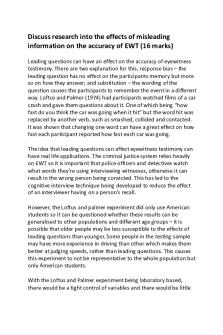P4. Turning effects of forces PDF

| Title | P4. Turning effects of forces |
|---|---|
| Course | Coordinated Sciences |
| Institution | Cambridge College |
| Pages | 1 |
| File Size | 52.3 KB |
| File Type | |
| Total Downloads | 74 |
| Total Views | 152 |
Summary
Notes for IGCSE Coordinated Sciences...
Description
*Coordinates to IGCSE Coordinated Sciences SYLLABUS (0645)*
IGCSE - Coordinated Sciences (PHYSICS) STUDY GUIDE - P4 ● ● ● ● ●
A pivot is the central point on which an object can turn. The quantity that tells us the turning effect of a force about a pivot is its moment. The moment of a force is bigger if the force is bigger. The moment of a force is bigger if it acts further from the pivot. The moment of a force is greatest if it acts at 90 to the object it acts on.
●
A beam is a long, rigid object that is pivoted at a point- if it's balanced, the moments of the two forces are cancelled out. This means the beam is in equilibrium, meaning the forces must be balanced (no resultant force) and the turning effects of the forces must be balanced (no resultant turning effect). Unit for the moment is Nm (because we multiply distance which is m with force which is N). Moment of a force is the turning effect of a force about a point. Moment of a force = force * perpendicular distance from pivot to force. Another way to see if the beam is in equilibrium is if total clockwise moment = total anticlockwise moment. Principle of moments refers to the idea of an object being balanced when anticlockwise and clockwise moments are equal. How to work out a question: identify clockwise and anticlockwise forces FIRST: 20 N at a distance of 0.5 m and 10 N at a distance of 1.5 m (identify the anticlockwise force and name it F). (20 * 0.5) + (10 * 1.5) = F * 0.5 10 Nm + 15 Nm = F * 0.5 25 Nm = F * 0.5 F = 25 Nm/0.5 m = 50 N
●
● ● ● ● ● ●
●
● ●
Example of stability: if a glass is upright, it’s weight acts downwards and the contact force of the table acts upwards- the two forces are in line so the glass is in equilibrium. If it is tilted, there is a pivot and the forces aren’t in line- glass weight is to the left (anticlockwise moment) and contact force is to the right. If the glass is tilted even more, it’s weight acts to the right of the pivot and has a clockwise moment (glass falls over). This is because all the mass is concentrated at a single point (center of mass). The center of mass in a human who is fairly symmetrical, lies in the middle of the body....
Similar Free PDFs

P4. Turning effects of forces
- 1 Pages

P4 Radio SR4SDR - Memoria P4
- 16 Pages

Copy of Intermolecular Forces
- 5 Pages

THE EFFECTS OF CORRUPTION
- 5 Pages

Previo P4
- 9 Pages

Environmental Effects OF Quarrying
- 18 Pages

2... Effects OF Privation
- 2 Pages

P4 Cristalización
- 13 Pages

Physiological Effects of Massage
- 8 Pages

Legal effects of marriage
- 34 Pages

The turning notes final
- 8 Pages

Turning Moment Diagrams
- 8 Pages

P4 - guion
- 10 Pages

Effects of the Sugar REvolution
- 4 Pages
Popular Institutions
- Tinajero National High School - Annex
- Politeknik Caltex Riau
- Yokohama City University
- SGT University
- University of Al-Qadisiyah
- Divine Word College of Vigan
- Techniek College Rotterdam
- Universidade de Santiago
- Universiti Teknologi MARA Cawangan Johor Kampus Pasir Gudang
- Poltekkes Kemenkes Yogyakarta
- Baguio City National High School
- Colegio san marcos
- preparatoria uno
- Centro de Bachillerato Tecnológico Industrial y de Servicios No. 107
- Dalian Maritime University
- Quang Trung Secondary School
- Colegio Tecnológico en Informática
- Corporación Regional de Educación Superior
- Grupo CEDVA
- Dar Al Uloom University
- Centro de Estudios Preuniversitarios de la Universidad Nacional de Ingeniería
- 上智大学
- Aakash International School, Nuna Majara
- San Felipe Neri Catholic School
- Kang Chiao International School - New Taipei City
- Misamis Occidental National High School
- Institución Educativa Escuela Normal Juan Ladrilleros
- Kolehiyo ng Pantukan
- Batanes State College
- Instituto Continental
- Sekolah Menengah Kejuruan Kesehatan Kaltara (Tarakan)
- Colegio de La Inmaculada Concepcion - Cebu

